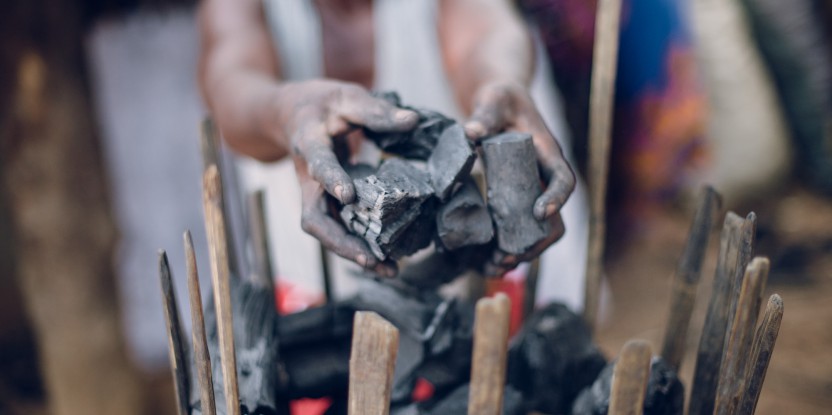
BOGOR, Indonesia—In terms of its value to daily lives and livelihoods across Africa, charcoal is black gold.
But as crucial as it is for cooking for millions of rural Africans, charcoal comes at a cost: the wood burned to create it comes from forests, generating substantial carbon emissions. Data on exactly how much has been hard to come by, but now there are hopes to change that.
In a recent report on Zambia’s progress in an international scheme to reduce carbon emissions through avoided deforestation (REDD+), researchers in the southern African country have highlighted just how much data is lacking.
“The main reason why we don’t have a lot of data on charcoal is that we have not really closely studied the production system,” said Davison Gumbo, a Zambia-based scientist with the Center for International Forestry Research (CIFOR).
Without hard facts, every attempt to calculate the carbon dioxide put into the atmosphere from southern Africa’s charcoal industry is educated guesswork at best.
The industry’s effects on the region’s forests are equally unclear. For REDD+ to be effective in Zambia and its neighbors, there needs to be more solid data on the “charcoal landscape.”
But how do you turn a vast, vague collection of uncertain, often word-of-mouth information into hard numbers?
Gumbo says attempts are under way to address these issues, but it will require hard, painstaking fieldwork in areas that are often remote and have difficult terrain. And typical forestry tools may not be the answer.
“There are a lot of other issues: The permit and licensing system, underhand trading, the quality of production—all of these ultimately have an effect on the amount of carbon put out into the atmosphere,” Gumbo said.
“We need to find ways to quantify all this, so in the future we will have data to base estimates of carbon emissions from charcoal on. We are looking at ways to do this, and hopefully some efforts will get under way in the next few months.”
REMOTE SENSING OF LITTLE USE
African conditions are not the easiest to work in at the best of times, but many of the regions of interest for REDD+ are remote even by African standards. Furthermore, some of the forests involved cross national borders. Some of the most popular tools used by forest researchers cannot be used in this environment—in particular, remote sensing, widely used to monitor tropical rainforests, is of little help.
“Our forests in southern Africa tend to be dry, open forests. One of the main tools we use to study forests elsewhere, remote sensing based on satellite images, does not work very well in this particular environment. It is very hard to distinguish agricultural land and dry, open forests with current methods of remote sensing. They look the same,” Gumbo said.
CALCULATING CARBON
The problem, nevertheless, slowly is being picked apart.
Output needs to be quantified, for example in terms of packets of charcoal or numbers of logs. The calorific value of the wood needs to be calculated — the amount of heat it produces when it burns and by implication the amount of carbon dioxide it produces. That in turn can depend on the wood’s density. The type of kiln also has an effect. So does the diameter of the logs: Larger logs tend to burn more.
Then there is Zambia’s licensing system. By law, people need a license to make charcoal in Zambia. In practice, it does not always happen—and when it does, license-holders tend to make three times the permitted amount of charcoal, in order to recoup the high cost of the license.
There is also a difference between people who make charcoal professionally on a full-time basis, and people who simply make it on the side to buttress their subsistence farming with something they can sell for cash. This second group often are not very efficient at making charcoal, Gumbo said.
If REDD+ is to work in Zambia and the rest of southern Africa, some way needs to be found for all these facets to be quantified and reduced to data that can be analyzed, Gumbo says.
And this has implications for southern Africa’s remaining forests. Informally, people are frequently cutting into forests around where they live, partly to make charcoal. Once they have cut it, they will claim the land is theirs and may subsequently go on to justify that legally. Then the forest is that much smaller.
Gumbo says there are potential ways to monitor and quantify the situation on the ground. Drones may be one option, if money can be found to pay for them. There are also hopes for improvements in remote sensing, which would enable better interpretation images from this type of terrain. In the near term, however, it is likely to mean a lot of careful monitoring at ground level.
The most important element is probably going to be ensure that the local people themselves are involved, Gumbo says.
“Ultimately they are the ones best placed to save the forests around them.”
For more information about this research, please contact Davison Gumbo at d.gumbo@cgiar.org.
CIFOR’s Global Comparative Study on REDD+ is supported in part by the CGIAR Research Program on Forests, Trees and Agroforestry and by NORAD, AusAID, DFID and the European Commission.
We want you to share Forests News content, which is licensed under Creative Commons Attribution-NonCommercial-ShareAlike 4.0 International (CC BY-NC-SA 4.0). This means you are free to redistribute our material for non-commercial purposes. All we ask is that you give Forests News appropriate credit and link to the original Forests News content, indicate if changes were made, and distribute your contributions under the same Creative Commons license. You must notify Forests News if you repost, reprint or reuse our materials by contacting forestsnews@cifor-icraf.org.

